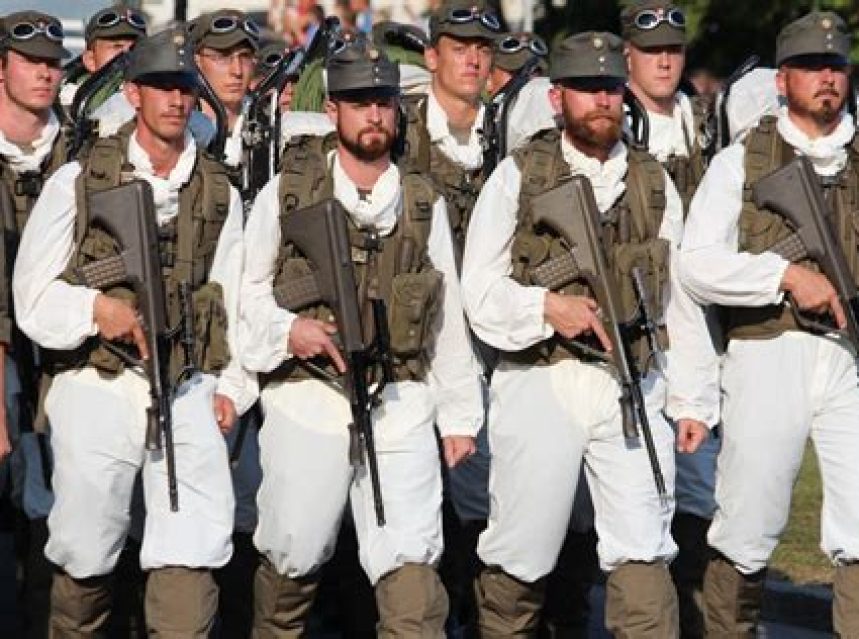Austrian Military Uniform

Welcome to our blog post on the fascinating world of Austrian military uniforms! In this article, we will delve into the history, significance, design, colors, and evolution of these iconic uniforms. From their humble beginnings to their enduring influence on the world of fashion, Austrian military uniforms have captivated both military enthusiasts and fashion aficionados alike. Join us as we explore the rich heritage and timeless style of these uniforms, highlighting their historical importance and enduring impact on the world of fashion. Let us embark on this enlightening journey through the chronicles of Austrian military uniforms!
History of Austrian Military Uniforms
The history of Austrian military uniforms is a fascinating topic that reflects the rich military tradition of this European nation. From the early days of the Habsburg Empire to the modern Austrian Armed Forces, the evolution of these uniforms has not only showcased the distinctive design and colors but also played a significant role in influencing fashion trends.
One of the earliest recorded instances of Austrian military uniforms can be traced back to the 16th century. During this period, the Habsburg rulers recognized the importance of distinguishing their soldiers on the battlefield. The uniforms were designed to not only provide a sense of identity but also served practical purposes such as protection and increasing visibility.
The design and colors of Austrian military uniforms have undergone many transformations throughout history. During the reign of Empress Maria Theresa in the 18th century, the uniforms were characterized by rich and colorful brocade fabrics, adorned with intricate embellishments. This extravagant style continued into the Napoleonic era, where the uniforms showcased a blend of French and Austrian influences, reflecting the political and cultural dynamics of the time.
- Distinctive features of Austrian military uniforms:
- Facings: A prominent feature of Austrian military uniforms has been the use of facings, which are colored patches or trimmings on the collars, cuffs, and turnbacks. These facings served to distinguish different regiments and branches of the army.
- Headgear: Over the centuries, various styles of headgear have been worn by Austrian troops, including tricorn hats, helmets, shakos, and berets. The design and color of the headgear often matched the uniform, maintaining a cohesive and visually striking appearance.
- Insignia and decorations: Austrian military uniforms have been adorned with badges, medals, and ribbons to denote rank, achievements, and membership in prestigious orders. These insignia not only added to the visual appeal but also emphasized the wearer’s accomplishments and status.
| Period | Features |
|---|---|
| 16th – 17th century | Simple designs with practical elements |
| 18th century | Elegant brocade fabrics and intricate embellishments |
| Napoleonic era | Cross-pollination of French and Austrian styles |
The influence of Austrian military uniforms on fashion cannot be underestimated. Throughout history, military fashion has often been emulated by civilians, and Austria has been no exception. Elements such as braided details, epaulettes, and double-breasted coats have made their way from the military arena to civilian clothing. This cross-pollination has not only influenced formal attire but also permeated casual and street fashion, showcasing the enduring appeal of military aesthetics.
In conclusion, the history of Austrian military uniforms is a testament to the nation’s military heritage and creative design. The distinct features, colors, and evolving styles of these uniforms have played a significant role in shaping both military and civilian fashion trends. From practicality to visual appeal, the uniforms tell a story of centuries-old traditions and continue to captivate with their unique and iconic characteristics.
Significance of Austrian Military Uniforms
The significance of Austrian military uniforms can be traced back to their rich history and illustrious tradition. The uniforms worn by the Austrian military not only served as a means of identification but also represented a symbol of strength, authority, and national pride. The design and colors of these uniforms were carefully chosen to reflect the values and ideals of the Austrian military, while also providing practicality and functionality on the battlefield.
One of the key aspects of the significance of Austrian military uniforms lies in their historical context. Throughout Austria’s history, the military played a crucial role in defending the nation and maintaining its sovereignty. The uniforms worn by Austrian soldiers became a visible reminder of their dedication, loyalty, and bravery. The sight of soldiers in their impeccable uniforms instilled a sense of pride and confidence among the Austrian people, fostering a strong national identity.
In addition to their historical importance, the design and colors of Austrian military uniforms also hold symbolic meaning. The intricate details and embellishments on these uniforms were often inspired by Austria’s rich cultural heritage, incorporating elements of traditional dress and regal aesthetics. The use of symbols, such as crests, badges, and emblems, showcased the military’s affiliation and allegiance to the country, while also serving as a visual representation of their achievements and honors.
- A symbol of discipline: The uniforms served as a powerful tool in instilling discipline and maintaining order within the military ranks. The strict adherence to specific dress codes and regulations fostered a sense of unity and cohesion among the soldiers.
- Identification and recognition: The design and colors of Austrian military uniforms allowed for easy identification and recognition on the battlefield. It facilitated communication and coordination among troops, minimizing the chances of friendly fire and confusion.
- Inspiring confidence: The immaculate appearance of Austrian soldiers in their uniforms had a profound impact on both the military personnel and the civilian population. It instilled a sense of confidence, trust, and respect for the military, enhancing their reputation and effectiveness.
| Uniform Component | Significance |
|---|---|
| Colors | The choice of colors in Austrian military uniforms often had symbolic meanings. For example, red was associated with bravery and valor, while gold represented prestige and honor. |
| Rank Insignia | The rank insignia displayed on the uniforms allowed for clear identification of the hierarchical structure within the military, ensuring effective chain of command and proper leadership. |
| Decorations | The decorations and medals worn on the uniforms served as a visual representation of the soldier’s achievements, valor, and dedication to the service of their country. |
Overall, the significance of Austrian military uniforms extends beyond mere attire. They embody a sense of history, tradition, and national identity. Through their design, colors, and symbolism, these uniforms served as a powerful tool in fostering discipline, recognition, and confidence within the military ranks. They played a significant role in shaping Austria’s military heritage and continue to evoke a sense of respect and admiration for the nation’s armed forces.
Design and Colors of Austrian Military Uniforms
When it comes to military uniforms, design and colors play a crucial role in representing a country’s identity and heritage. Austrian military uniforms have a rich history, with distinct features that have evolved over the years. The design of these uniforms has been carefully crafted to reflect the country’s military prowess and cultural traditions. Let’s delve into the fascinating world of Austrian military uniforms and explore the significance behind their design and colors.
Colors:
The colors used in Austrian military uniforms are not chosen randomly; each color holds a specific meaning and represents different aspects of the country’s military culture. One of the prominent colors used in Austrian military uniforms is red, symbolizing strength, courage, and valor. This bold color signifies the bravery and determination of the Austrian soldiers. Another significant color is white, representing purity, innocence, and peace. White is often used in ceremonial uniforms, reflecting the country’s commitment to peacekeeping efforts.
Design:
The design of Austrian military uniforms is known for its elegance and attention to detail. The uniforms feature intricate embroidery, ornate buttons, and decorative elements that add a touch of regality. The fit of the uniforms is tailored and streamlined, allowing for ease of movement without compromising on sophistication. Austrian military uniforms often incorporate traditional elements, such as braided trims, epaulettes, and unique headgear, which add an element of grandeur and cultural heritage.
Significance:
The design and colors of Austrian military uniforms hold great significance in showcasing the country’s military legacy and traditions. The choice of colors reflects the values and characteristics that the Austrian military upholds, while the design elements signify the honor, discipline, and professionalism exhibited by the soldiers. These uniforms not only serve a functional purpose but also act as symbols of national pride and unity.
In conclusion, the design and colors of Austrian military uniforms are carefully crafted to represent the country’s military heritage and cultural identity. The choice of colors holds specific meanings, while the design elements showcase elegance, attention to detail, and cultural traditions. The significance of these uniforms goes beyond their functional purpose, acting as powerful symbols of pride and honor. Next time you see an Austrian soldier in their distinctive uniform, take a moment to appreciate the thought and craftsmanship that goes into their design.
This post is part of a series exploring various aspects of Austrian military uniforms. Stay tuned for more fascinating insights into the history, evolution, and influence of these iconic uniforms!
Evolution of Austrian Military Uniforms
Austrian military uniforms have a long and fascinating history, evolving over the centuries to reflect changes in warfare, society, and fashion. From their humble beginnings in the 17th century to their modern-day iterations, these uniforms have witnessed significant transformations in design, colors, and functionality. Let’s delve into the captivating journey of the evolution of Austrian military uniforms and discover the key milestones that have shaped their appearance and significance.
Listed below are the distinct phases in the evolution of Austrian military uniforms:
| Phase | Description |
|---|---|
| 17th – 18th Century | In the early years, Austrian military uniforms were highly influenced by the styles of neighboring countries. The infantry wore long coats with bright colors and intricate embroidery, while cavalry units donned elaborate, ornamental uniforms to showcase their status. The design often featured intricate detailing, emphasizing the wealth and power of the noble officers. |
| 19th Century | The 19th century witnessed significant changes in the Austrian military uniforms. With the emergence of new technologies and warfare tactics, the uniforms evolved to prioritize practicality and comfort. The iconic Hussar uniform, with its distinct braided jackets and plumed hats, became synonymous with the Austrian military during this period. |
| World War I | During World War I, Austrian military uniforms underwent a drastic transformation to adapt to the demands of modern warfare. The traditional grandeur gave way to more muted and functional designs. Practicality and camouflage became crucial elements, as soldiers needed to blend into the battlefield. This era saw the introduction of standard-issue field gray uniforms for the troops. |
| Modern Era | In the modern era, Austrian military uniforms have adapted to reflect the changing role of the armed forces. The emphasis has shifted towards versatility, durability, and comfort. The uniforms now incorporate modern fabrics and technologies to ensure functionality while maintaining a sense of tradition. |
The evolution of Austrian military uniforms has not only been influenced by practical needs but has also left a significant impact on the world of fashion. The unique designs, vibrant colors, and intricate details of these uniforms have inspired fashion trends and influenced the creation of civilian clothing. Elements such as braided jackets, tassels, and distinct headgear have found their way into fashion runways and iconic styles.
Throughout history, Austrian military uniforms have portrayed the identity and values of the nation’s armed forces. From the opulence and elegance of the early years to the practicality and functionality of the modern era, the evolution of these uniforms showcases the changing nature of warfare and the influence of society and fashion trends. The rich history and significance of Austrian military uniforms continue to captivate both military enthusiasts and fashion aficionados to this day.
Influence of Austrian Military Uniforms on Fashion
The influence of Austrian military uniforms on fashion cannot be underestimated. Throughout history, military uniforms have played a significant role in shaping fashion trends and styles. Austrian military uniforms, in particular, have had a profound impact on the world of fashion, influencing designers, artists, and even everyday individuals. The unique design, colors, and details of Austrian military uniforms have been incorporated into various fashion garments and accessories, creating a distinct and timeless aesthetic.
One of the major reasons for the influence of Austrian military uniforms on fashion is their rich history and symbolism. Austrian military uniforms have been worn by soldiers for centuries and have come to represent power, authority, and discipline. Designers and fashion enthusiasts are intrigued by the visual impact and symbolism associated with these uniforms, often incorporating elements such as epaulettes, braiding, and intricate buttons into their designs.
Additionally, the design and color palette of Austrian military uniforms have inspired countless fashion collections. The sharp lines, tailored silhouettes, and precise detailing found in these uniforms have been translated into elegant and structured garments. The color combination of red, black, and gold, which are commonly associated with Austrian military uniforms, is frequently seen on fashion runways and in designer collections, adding a regal and luxurious touch.
- Austrian military uniforms have influenced the design of coats and jackets, with double-breasted styles and ornate buttons frequently used in fashion.
- The use of braiding and epaulettes in military uniforms has inspired the design of shoulder details and embellishments on dresses, blouses, and outerwear.
- The color combination of red, black, and gold, often seen in Austrian military uniforms, is frequently used in formal eveningwear and accessories.
- Austrian military-inspired accessories, such as hats and boots, have made their way into mainstream fashion, adding a touch of military chic to an outfit.
The influence of Austrian military uniforms on fashion can also be seen in historical periods such as the 19th century Biedermeier era, where military-inspired elements were prominent in men’s and women’s attire. The military aesthetic has continued to be reinvented and reimagined throughout the years, influencing various fashion subcultures, such as steampunk and military-inspired streetwear.
In conclusion, Austrian military uniforms have had a significant influence on the world of fashion. Their rich history, symbolism, and distinctive design elements have been incorporated into countless fashion garments and accessories, creating a timeless and elegant aesthetic. Whether it’s the structured silhouette of a coat or the intricate detailing on a dress, the influence of Austrian military uniforms on fashion is undeniable.
Frequently Asked Questions
1. What is the history of Austrian military uniforms?
The history of Austrian military uniforms dates back centuries, with their distinctive style evolving over time.
2. What is the significance of Austrian military uniforms?
Austrian military uniforms not only serve practical purposes, but also hold symbolic significance, representing the country’s military heritage and national identity.
3. Can you describe the design and colors of Austrian military uniforms?
Austrian military uniforms often feature intricate designs, including unique patterns and details, while the colors vary depending on the branch and rank.
4. How have Austrian military uniforms evolved over time?
Austrian military uniforms have undergone considerable changes, influenced by various historical and societal factors, adapting to the needs of the military and reflecting shifting fashion trends.
5. Have Austrian military uniforms influenced fashion trends?
Yes, Austrian military uniforms have had a notable influence on fashion trends, with elements of their design incorporated into civilian clothing and accessories.
6. How have Austrian military uniforms influenced fashion in modern times?
Modern fashion designers have frequently drawn inspiration from Austrian military uniforms, with their distinct elements often reinterpreted in contemporary clothing collections.
7. Are there any notable examples of Austrian military uniform-inspired fashion trends?
Yes, notable examples include the use of decorative cordwork, coats with high collars, and golden embellishments, among other design elements, seen in both historical-inspired and avant-garde fashion.



